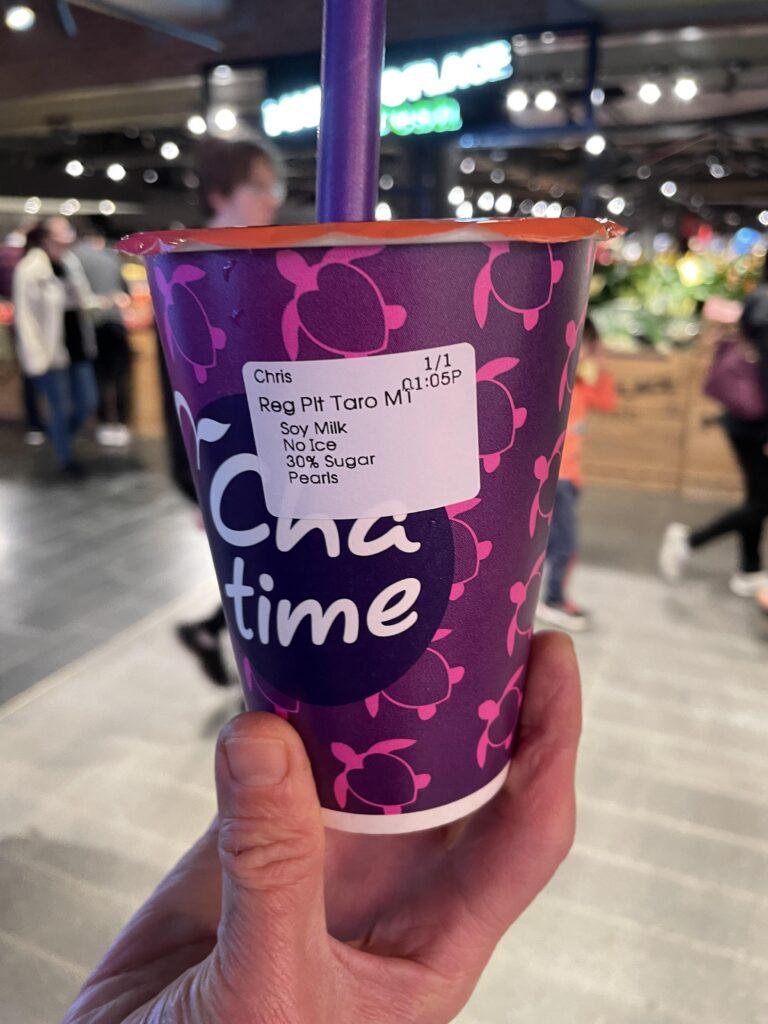Taro milk tea has quickly become a favorite among tea lovers, and for good reason. A delightful fusion of the sweet, nutty flavor of taro root with creamy milk and bold tea flavors, it’s truly a treat for the senses. Whether you’re a seasoned boba aficionado or new to the world of bubble tea, there’s something undeniably captivating about this purple-hued concoction.
Originating from Taiwan, taro milk tea (also known as taro bubble tea) is typically made using taro powder mixed with black or green tea, sugar, ice, and your choice of milk—whole milk for traditionalists or almond and coconut milks for those seeking dairy-free alternatives. The unique purple color comes from the starchy root vegetable—taro—that it’s made from. When cooked right, taro imparts a subtly sweet taste that’s reminiscent of sweet potato but also has its own distinctively nutty flavor profile.
Making your own taro milk tea at home isn’t as daunting as you might think; all you need are some simple ingredients like raw or powdered taro and tapioca pearls (for that authentic boba experience). Not only is it fun to make your own custom beverage at home—you also get control over what goes into your drink. Plus, there are many health benefits linked to consuming this delicious root vegetable! From its high fiber content to essential nutrients such as potassium and vitamin C—it’s no wonder why taro is one veggie that’s making waves in the drink scene!
What is Taro Milk Tea?
Stepping into a boba shop, it’s likely that you’ve seen taro milk tea on the menu. This unique drink, popular among tea lovers and renowned for its distinctive purple color, has garnered attention worldwide. But what exactly is taro milk tea?
In essence, taro milk tea is a delightful blend of tea and milk infused with the flavor of taro root—a starchy root vegetable similar to sweet potato. The key ingredient, taro root, lends an intriguing nutty taste to the beverage.
Originating from Southeast Asia, this root vegetable boasts many health benefits. It contains vitamins and minerals beneficial to health like vitamin C and potassium. However, in most cases for boba shops or when making your own at home raw taro isn’t used directly due to its complex preparation process involving peeling and boiling.
Instead, most places use powdered form – taro powder – which simplifies the process while retaining much of the original flavor. The type of tea used can vary between green tea leaves or black ones depending on personal preference or available options at a bubble tea shop.
The classic recipe also includes tapioca pearls—thus giving rise to another name: “taro bubble tea”. These chewy additions add texture making each sip an adventure! Lastly sweeteners such as condensed milk are often added enhancing overall taste
In terms of visual appeal alone, it’s hard not to be intrigued by this drink’s signature hue — an appealing shade derived from cooked taro roots that makes every cup Instagram worthy!
For those wondering ‘what does taro milk tea taste like?’ — it’s made with notes of vanilla combined with slight nutty undertones providing layers complexity yet maintaining simplicity sweetness; it tastes bit like vanilla-infused almonds mixed up mashed potatoes… truly something else!
So next time you’re browsing through different bubble teas at your local boba shop remember try out some deliciously creamy subtly earthy uniquely purple-colored concoction known as Taro Milk Tea.
What Does Taro Taste Like Inside Taro Bubble Tea?
When one steps into a boba shop, they might find themselves intrigued by the unique offering of taro milk tea on the menu. So, what does this popular boba tea flavor taste like?
Uncooked taro root or raw taro, a starchy root vegetable, is not very appealing to the palate. It’s similar to a potato but has an earthier and more nutty taste. The flavor of taro transforms remarkably when cooked though. Cooked taro takes on a sweet and nutty flavor that’s been likened to sweet potatoes or even vanilla.
The deliciousness doesn’t end there! When you mix in tapioca pearls and make it into taro bubble tea, things get even better! You can make taro milk tea at home using powdered taro for convenience or use real fresh taro if you’re after authenticity.
The sweetness from condensed milk (or any type of milk substitute like almond milk or coconut milk) combined with the distinctively rich and creamy flavor of boiled then mashed purple-colored taro creates an almost dessert-like drink that many bubble tea lovers can’t resist!
Now let’s talk about taro powder. It’s made from dehydrated then finely ground cooked taro roots. Taro powder imparts that classic pastel purple color we associate with all things ‘taro’. Not only does it lend color but also infuses your boba tea with its signature earthy-sweet-nutty profile.
A standard cup of taro bubble tea comes loaded with chewy tapioca pearls (aka “boba”) steeped in freshly brewed green or black teas mixed with either whole or condensed milk along with some sort of sweetener such as sugar syrup.
If you’ve ever wondered what sets apart this beverage at your local bubble tea shop – it’s made differently depending on each store’s recipe; some places stick to using instant mixes while others pride themselves on serving drinks made from scratch using real root vegetables.
It should be noted that while the combination may sound odd to those unacquainted, many love how harmoniously these elements blend together creating something truly delightful yet refreshingly different – much like jazz music!
So next time when you see ‘TARO’ flashing across the menu board at your favorite boba shop, don’t hesitate – give it try! You might just discover your new favorite drink!
What Does Taro Milk Tea Taste Like?
When stepping into a boba shop, one might wonder, “What does taro milk tea taste like?” There’s something uniquely captivating about its vibrant purple color. It’s no surprise that taro bubble tea has become a favorite among tea lovers.
Firstly, it’s crucial to understand what taro is. The star ingredient of this popular boba tea flavor is the taro root, a starchy root vegetable similar to sweet potato. When cooked, taro tastes mildly sweet with a hint of vanilla and nuts — hence the often described nutty taste of taro milk teas.
Now, imagine this subtly sweet and nutty flavor combined with creamy milk in a cold refreshing beverage. That’s what you get when you order a cup of taro milk tea at your local bubble tea shop or make it at home using powdered or fresh taros.
Often compared to other starchy foods such as potatoes and yams for its texture and taste, cooked taro gives this drink an enticing thickness without overwhelming sweetness. Some even believe that taro tastes somewhat like cookies or cake batter! This makes the drink not only delicious but also fulfilling.
However, the flavor can slightly vary depending on how it’s made:
- If made with raw taro root, there will be more earthy notes in your cup.
- Using powdered instant taro may result in less natural but sweeter flavors.
- The type of milk used can also affect the overall taste — whole milk provides richness; almond or coconut milks add their unique undertones.
To elevate its creaminess further, some versions include condensed milk while others use coconut milk for an exotic twist. A popular choice is mixing green or black teas with the concoction for added depth of flavors.
And let’s not forget those signature tapioca pearls (also known as boba)! They offer delightful chewiness to every sip making each moment indulging this drink an exciting experience!
The beauty lies within these variations: from slightly earthy tones if made from raw roots to sweeter hints when prepared with instant powder mixtures; different types of milks infusing their own characteristics; all culminating into an alluring blend called Taro Milk Tea!
Remember though – while most people find it pleasant and addictive, just like any food item out there – whether someone loves it truly depends on individual preference! So next time you’re at your local boba shop staring at that menu board wondering about trying something new… Why not give Taro Milk Tea a go?
Does Taro Milk Tea Have Caffeine? Taro Powder Facts in Bubble Tea
Ever wondered about the caffeine content in your favorite taro milk tea? You’re not alone. Many tea lovers have this question on their minds when they step into a bubble tea shop.
Taro milk tea, also known as taro bubble tea, is a popular boba tea flavor made from the starchy root vegetable called taro. The sweet and nutty taste of taro makes it a hit among many boba shop regulars.
The primary components of this delicious drink are typically taro root powder, fresh or powdered taro, green or black tea, and some type of milk – often whole milk, almond milk, coconut milk or condensed milk.
When it comes to caffeine content in your cup of taro milk tea, it primarily depends on the base used for brewing. If the tea made uses green or black tea leaves, then yes, there’s likely going to be caffeine present. For example:
| Tea Base | Average Caffeine Content (mg) |
|---|---|
| Green Tea | 30-50 |
| Black Tea | 40-70 |
However if it’s made with other bases that don’t contain caffeine like herbal infusions or fruit juices then you’re looking at a caffeine-free treat!
Additionally remember that while raw taro root itself does not contain any caffeine its unique flavor often pairs well with teas that do.
It’s important to note that different variations can impact how much caffeine ends up in your final drink – whether you make it at home using raw ingredients like cooked taro and tapioca pearls; use instant mixes which might include powdered forms; order from different boba shops; whether they use real leaves versus powders etc.
So next time you visit your local bubble tea shop and try a refreshing glass of purple colored goodness know what goes into making this beloved beverage! And if you’re sensitive to stimulants ask them about their process before ordering – most places will be happy to accommodate!

What Are Taro Boba Pearls Used in Boba Tea?
Diving into the world of bubble tea, you’ll come across an array of flavors. However, none stands out quite like taro milk tea. Not only for its unique purple color but also for its sweet and nutty taste that many find irresistible. So, what are those intriguing boba pearls in your taro milk tea? Let’s break it down.
Taro boba pearls are essentially tapioca pearls that have been steeped in a mixture made from taro root or taro powder. The taro root, a starchy root vegetable similar to a potato, is well-known for its health benefits and distinct flavor which tastes a bit like sweet potatoes.
In the process of making these flavorful pearls, first off, the taro root is boiled until it’s soft enough to be mashed into a paste or processed into powdered form – powdered taro. It’s then mixed with sugar and water before being added to cooked tapioca pearls.
The result? You get these delightful chewy morsels known as taro boba pearls. They carry not just the texture but also the unique flavor of taro – all while adding some fun to your drink!
However, if you’re wondering about how healthy these little treats are, here’s something interesting: despite their small size and sweet taste they bring along several health benefits since the taro itself is packed with fiber and various essential nutrients.
It’s important to note though that while many bubble tea shops use real raw taro root, others opt for instant options like pre-made mixes or syrups which often contain artificial colors and flavors. Therefore when ordering your next cup at any boba shop remember this tip: always ask whether they use fresh ingredients!
Making milk tea with genuine taro at home might seem daunting at first glance but believe us – it’s simpler than you think! All you need is some cooked or powdered form of this wonder plant plus other basic ingredients such as whole milk (or almond/coconut milk) along with black/green/jasmine tea leaves according to preference; mix everything up nicely… voila! Your homemade delicious taro milk tea will be ready in no time!
To sum up: If you haven’t tried taro bubble tea yet because you’ve never seen one on any menu before – now’s high time! This popular drink has won over countless hearts worldwide due to both its eye-catching appearance plus irresistible combo consisting mainly outta cool sweetness accompanied by charming tiny balls filled full bursting joy inside each sip taken thereby creating an unforgettable experience every single time enjoyed by everyone who loves exploring new exciting food adventures around globe today therefore why not give shot soon too eh?!
Where Does Taro Inside Taro Tea Come From?
When it comes to taro milk tea, one can’t help but wonder about its origin. The star ingredient, taro, is a starchy root vegetable similar to a sweet potato. It’s the key player in the unique flavor of this popular boba tea.
The roots of taro are found deep in Southeast Asian cuisine. This vibrant purple root vegetable has been utilized for centuries as a staple food source and now serves as an exciting twist in bubble tea shops worldwide.
The process of transforming raw taro into a delectable addition to your boba shop order involves several steps:
- Fresh taro is peeled, much like potatoes.
- Once peeled, it’s boiled until soft.
- After boiling, the cooked taro is mashed or ground into fine powder form.
- This powdered taro then goes on to flavor your favorite tea blends.
Taro bubble tea made with real taro stands out due to its unique purple color and nutty taste that differentiates it from standard black or green teas. Its distinct taste can be described as sweet yet slightly earthy – imagine if you crossed vanilla with something like a potato!
Nowadays, many places use instant tapioca pearls for convenience but let’s not forget that traditional pearl milk tea uses real tapioca balls made from scratch! And when mixed with these pearls (boba) and some type of milk (whole milk, almond milk or condensed coconut milk), you get what’s known as taro bubble tea.
Making this delicious concoction at home isn’t impossible either; all you need are green or jasmine tea leaves along with some other ingredients including cooked & mashed fresh raw taro (or convenient powdered form) along with desired sweeteners such as honey or sugar syrup.
So next time you’re sipping on that frothy blend at your favorite bubble tea shop remember: behind every cup lies the humble yet versatile root known as TARO!
Taro Milk Tea Calories If Taro Tea Made With Boba
For many tea lovers, taro milk tea has become a favorite choice at boba shops. It’s unique purple color and nutty taste have made it one of the most popular boba tea flavors. But what about the calories in this delicious drink? Let’s dive into it.
Taro milk tea is often made with taro powder, black or green tea leaves, and a type of milk such as whole, almond or coconut milk. The sweet taste comes from added sugar and sometimes condensed milk. However, since the taro root is starchy like potatoes, even without any sweeteners it still contains some natural sugars.
The real game changer for calorie count in your cup of taro bubble tea comes when you add boba or tapioca pearls. These chewy little balls are also loaded with sugar and carbs which significantly increase the total calorie content.
Here’s a simple breakdown:
| Ingredient | Calories |
|---|---|
| Taro Powder | 70-100 |
| Black/Green Tea | 2-5 |
| Milk (depends on type) | 50-150 |
| Sugar/Sweeteners | 50-200 |
| Boba/Tapioca Pearls (1/4 cup) | 100-150 |
These figures can vary depending on portion sizes, exact ingredients used by each bubble tea shop and how much sugar is added to your drink.
To conclude:
- A standard serving of taro bubble tea made with whole milk could range from approximately 300 to 600 calories.
- If almond or coconut milk is used instead, that might reduce the calorie count slightly.
- Extra toppings like more boba will further increase these numbers.
Even though it’s not exactly a low-calorie beverage option on the menu at your local boba shop or if you make it at home yourself; for those who love its unique flavor – there’s no substitute for that creamy blend of fresh-tasting green/black tea mixed with flavorful taro!

